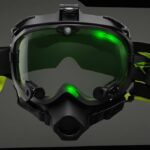Do you ever feel like your clothing is not providing enough protection against the sun’s rays? Are you curious to know if near infrared radiation can penetrate your clothing? Near infrared radiation is invisible to the human eye and it is known to have a variety of health effects. In this article, we will explore whether near infrared radiation can penetrate clothing and what effects it may have on your health.

Contents
Does Near Infrared Light Penetrate Clothing?
Near Infrared (NIR) light is a type of light that is invisible to the human eye and lies between the visible spectrum of light and microwaves. As a result of its unique properties, NIR has a wide range of applications in areas such as medicine, communications, and security. One of the most discussed applications is the ability of NIR light to penetrate clothing.
The answer to this question is not a simple yes or no. It depends on the type of fabric, the wavelength of the NIR light, and its intensity. Generally speaking, light with wavelengths between 700 and 1400 nm can penetrate clothing to some extent. However, fabrics made from natural fibers such as cotton or wool will absorb more light than synthetic fabrics such as nylon or polyester. Therefore, the amount of NIR light that can penetrate clothing is dependent on the type of fabric and the wavelength of the NIR light.
What Exactly is Near Infrared Light?
Near Infrared (NIR) light is a type of light that is invisible to the human eye and lies between the visible spectrum of light and microwaves. This type of light is often referred to as “invisible light” because our eyes cannot detect it. NIR light has a longer wavelength than visible light and, as a result, has a lower energy level. This means that it is less likely to cause damage to human tissue or other materials.
NIR light has a wide range of applications in areas such as medicine, communications, and security. It can be used to detect objects in the dark, to diagnose medical conditions, and to transmit information. NIR light is also used in night vision goggles, which allow people to see in the dark.
How Does NIR Light Penetrate Clothing?
When NIR light is shone onto a fabric, it will penetrate the fibers of the fabric to a certain extent. The amount of penetration will depend on the type of fabric, the wavelength of the NIR light, and its intensity. Generally speaking, light with wavelengths between 700 and 1400 nm can penetrate clothing to some extent.
However, fabrics made from natural fibers such as cotton or wool will absorb more light than synthetic fabrics such as nylon or polyester. This is because natural fibers tend to be more absorbent than synthetic fibers. Therefore, the amount of NIR light that can penetrate clothing is dependent on the type of fabric and the wavelength of the NIR light.
What are the Benefits of NIR Light Penetrating Clothing?
The ability of NIR light to penetrate clothing has a range of benefits. One of the most important benefits is its use in security systems. NIR light can be used to detect the presence of an intruder, as well as the movement of people through a building. This type of security system is often used in high-security areas such as government buildings, banks, and airports.
NIR light can also be used to detect the presence of hazardous materials, such as explosives, which could be hidden under clothing. This type of detection system is often used in airports and other public spaces to ensure the safety of the public.
What are the Drawbacks of NIR Light Penetrating Clothing?
While the ability of NIR light to penetrate clothing has a range of benefits, there are also some drawbacks. One of the most significant drawbacks is the potential for privacy violations. NIR light has the potential to reveal details that are meant to be kept private, such as tattoos or body art.
In addition, NIR light can also be used to detect the presence of drugs or other illegal substances that may be hidden under clothing. This can lead to potential legal issues if the data is used in a court of law.
Conclusion
Near Infrared (NIR) light is a type of light that is invisible to the human eye and has a wide range of applications. The ability of NIR light to penetrate clothing has both benefits and drawbacks, depending on the type of fabric, the wavelength of the NIR light, and its intensity. NIR light can be used in security systems to detect the presence of an intruder and to detect the presence of hazardous materials. However, there is also the potential for privacy violations and legal issues if the data is used in a court of law.
Top 6 Frequently Asked Questions
Does Near Infrared Penetrate Clothing?
Question 1: What is Near Infrared (NIR)?
Answer: Near Infrared (NIR) is the part of the electromagnetic spectrum with wavelengths ranging from approximately 700 nm to 1 mm. It is located between visible light and microwaves in the electromagnetic spectrum and is invisible to the human eye. NIR is used for a variety of applications, including medical imaging, communication, and remote sensing.
Question 2: What are the properties of Near Infrared?
Answer: Near Infrared (NIR) has unique properties that make it useful for many different applications. It is able to pass through clouds and is not blocked by dust, smoke, fog, or other environmental factors. NIR is also able to penetrate surfaces and materials that are opaque to visible light, such as certain plastics and fabrics. In addition, NIR is safer than other forms of radiation, making it ideal for medical imaging applications.
Question 3: Does Near Infrared Penetrate Clothing?
Answer: Yes, Near Infrared (NIR) is able to penetrate clothing, although the amount of penetration depends on the type of fabric. NIR can penetrate most fabrics, such as cotton, polyester, nylon, and wool, to varying degrees. However, some fabrics, such as leather, are especially effective at blocking NIR radiation.
Question 4: What is the effect of Near Infrared on the Human Body?
Answer: Near Infrared (NIR) has beneficial effects on the human body when used in medical applications. NIR is able to penetrate the skin, allowing it to heat the body from the inside out. This helps to improve circulation, reduce inflammation, and promote healing. In addition, NIR can be used to help diagnose conditions such as cancer and other diseases.
Question 5: How is Near Infrared used in Imaging?
Answer: Near Infrared (NIR) is used in imaging applications due to its ability to penetrate surfaces and materials that are opaque to visible light. NIR imaging is used in a variety of medical procedures, including endoscopy, laparoscopy, and mammography. In addition, NIR imaging is also used in security and surveillance applications, as it can detect objects that are hidden from view.
Question 6: How can Near Infrared be used for Communication?
Answer: Near Infrared (NIR) can be used for communication applications, such as fiber optic communication. NIR can be transmitted through an optical fiber, allowing for faster data transfer rates than traditional copper wires. In addition, NIR is able to penetrate obstacles, such as walls and other structures, that can block traditional radio waves, making it an ideal choice for wireless communication systems.
Can near-infrared energy reach the brain for treatment of TBI? – Video abstract [78182]
The answer to the question of whether near infrared radiation can penetrate clothing is yes. Near infrared radiation, due to its wavelength, is able to travel through materials and into the body. While the amount that penetrates is minimal and does not pose a significant health risk, it is still important to be aware of this potential hazard and take appropriate precautionary measures when necessary. With the combination of advances in technology and a better understanding of the potential risks related to near infrared radiation, we can make smarter decisions regarding our health and safety.









